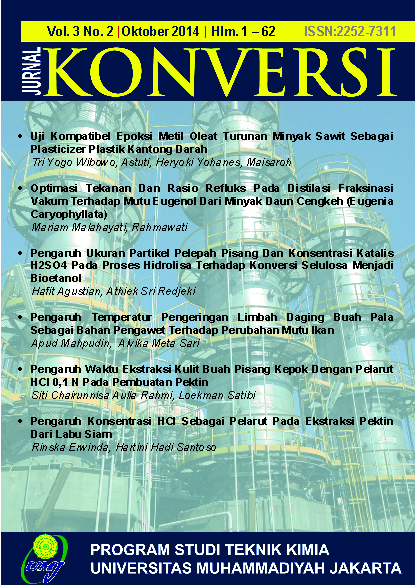UJI KOMPATIBEL EPOKSI METIL OLEAT TURUNAN MINYAK SAWIT SEBAGAI PLASTICIZER PLASTIK KANTONG DARAH
Main Article Content
Abstract
Dalam penelitian ini, plastik PVC dibuat dengan mencampur resin PVC dan plasticizer epoksi metil oleat di dalam sebuah mixer dan dicetak dengan metode PVC coating. Plastik PVC yang terbentuk dan kantong darah komersial dikarakterisasi dengan mengukur sifat-sifat mekanik (kuat tarik dan regang ulur) dan sifat kelarutan plasticizer dalam metanol. Adapun plasticizer epoksi metil oleat dibuat melalui rangkaian proses esterifikasi, dan epoksidasi. Epoksi metil oleat yang dihasilkan memiliki sifat-sifat yang lebih baik daripada produk komersial. Hal ini ditunjukkan oleh angka oksiran yang lebih tinggi dan angka iod yang lebih rendah daripada epoksi komersial. Uji kompatibel epoksi metil oleat sebagai plasticizer untuk produksi lembar plastik PVC menunjukkan hasil yang hampir sama (lebih rendah) dengan lembar plastik kantong darah komersial. Lembar plastik yang dihasilkan memiliki kuat tarik sebesar 15,7 Mpa dan regang putus 315 %. Sementara itu kantong darah komersial memiliki kuat tarik sebesar 19,2 Mpa dan regang putus 340 %. Adanya asam lemak yang tidak bereaksi pada proses epoksidasi menyebabkan berkurangnya kekuatan perpaduan antara matriks dan fase terdispersi. Hal ini yang menyebabkan nilai kuat tarik dan regang putus plastik menurun. Adapun jumlah senyawa ftalat (DOP) yang terlarut dalam metanol dari produk plastik PVC dan kantong darah komersial masing-masing sebesar 42,1% dan 40,2%. Jumlah DOP yang terlarut baik dari produk plastik PVC maupun kantong darah komersial masih memenuhi standar kesehatan. Kata Kunci : oleat, minyak sawit, kantong darah
Article Details
Issue
Section
Articles
Authors who publish with this journal agree to the following terms:
- Authors retain copyright and grant the journal right of first publication with the work simultaneously licensed under a Creative Commons Attribution License that allows others to share the work with an acknowledgement of the work's authorship and initial publication in this journal.
- Authors are able to enter into separate, additional contractual arrangements for the non-exclusive distribution of the journal's published version of the work (e.g., post it to an institutional repository or publish it in a book), with an acknowledgement of its initial publication in this journal.
- Authors are permitted and encouraged to post their work online (e.g., in institutional repositories or on their website) prior to and during the submission process, as it can lead to productive exchanges, as well as earlier and greater citation of published work (See The Effect of Open Access).
